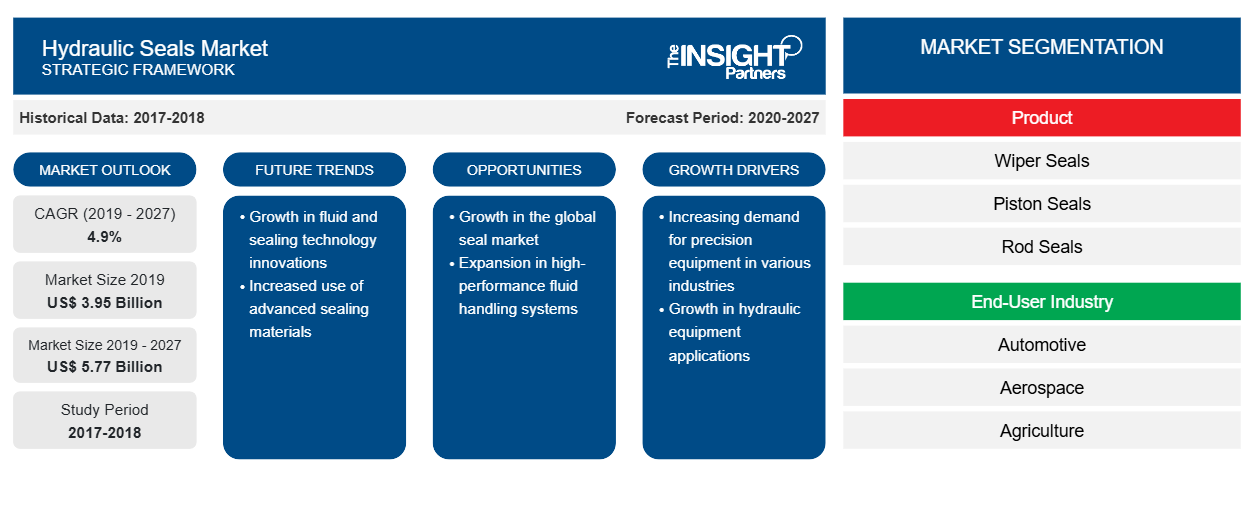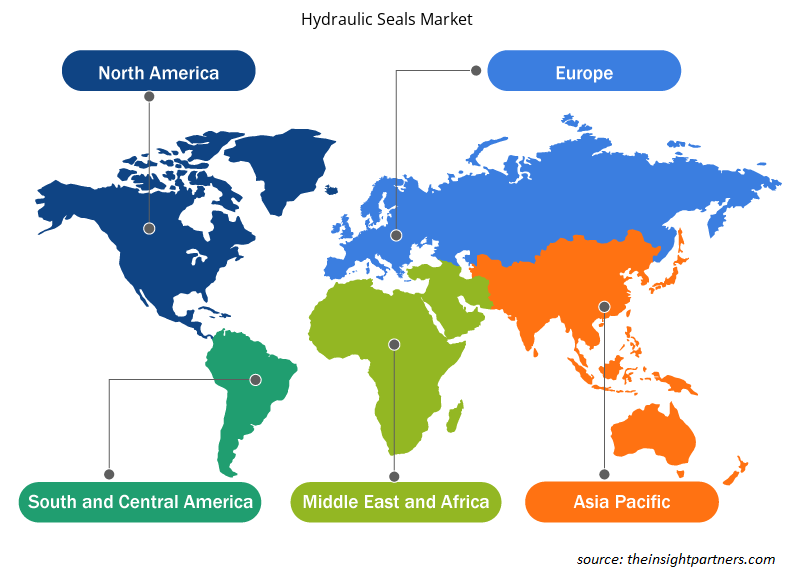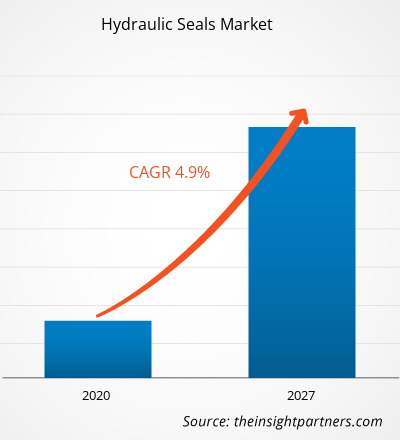The hydraulic seals market was valued at US$ 3,950.09 million in 2019 and is projected to reach US$ 5,770.71 million by 2027; it is expected to grow at a CAGR of 4.9% from 2020 to 2027.
Hydraulic seals are highly preferred by various end-user industries and are broadly used in hydraulic transmission systems. This is due to the numerous advantages offered by hydraulic sealing systems in providing efficient leakage protection control. Hydraulic seals are critical in machinery equipment. Process industries have unfavorable conditions that generally deteriorate the material of the equipment. These conditions have forced the vendors to manufacture hydraulic seals with high-quality materials that can withstand heavy-duty operations. Hydraulic seals are highly recognized for their excellent sealing ability in oil and pressure systems. Hydraulic seal prohibits dirt from entering any part of the internal mechanical system and thereby prevents contamination.
North America is estimated to register the fastest CAGR in the Hydraulic Seals market over the forecast period. Several domestic and multinational companies in the hydraulic seals market already have a strong foothold in North American countries like the U.S. and Canada. Hydraulic seals are employed throughout aircraft hydraulic systems to reduce the internal and external leakage of hydraulic fluid. They prevent the loss of system pressure. The increased utilization of hydraulics and pneumatics in aircraft systems has stimulated the aerospace industry's adoption of hydraulic seals. Manufacturers in the region are striving to provide innovative products to their customers and thereby to gain a huge share in the market. For instance, in 2020, Greene Tweed, a global manufacturer of high-performance seals located in the U.S, introduced its new L-Cap seal for hydraulic systems in aerospace applications. Made with proprietary Avalon PTFE, Arlon PEEK, and elastomer materials, the new L-Cap seal is anticipated to exceed industry standards for performance and durability, minimal fluid leakage, ensuring long service life, and excellent performance across a wide temperature range.
The ongoing COVID-19 pandemic has altered the status of the hydraulic seals industry. The chemical & materials is one of the major industries suffering serious disruptions such as supply chain breaks, technology events cancellations, and office shutdowns. As much as the outbreak has distorted operational efficiency and disrupted the value chains due to the sudden shutdown of national and international boundaries, it has also positively impacted the demand for hydraulic seals. However, as the economies are planning to revive their operations, the demand for hydraulic seals is expected to rise globally in the coming months. Although, the focus over just-in-time production is another factor hindering the hydraulic seals market growth. Also, the increasing prevalence of COVID-19 cases is likely to grow the demand for hydraulic seals during the forecast period. Further, significant investments by prominent companies in the development of advanced products is, yet, another factor supporting the market growth
Customize This Report To Suit Your Requirement
You will get customization on any report - free of charge - including parts of this report, or country-level analysis, Excel Data pack, as well as avail great offers and discounts for start-ups & universities
Hydraulic Seals Market: Strategic Insights

- Get Top Key Market Trends of this report.This FREE sample will include data analysis, ranging from market trends to estimates and forecasts.
You will get customization on any report - free of charge - including parts of this report, or country-level analysis, Excel Data pack, as well as avail great offers and discounts for start-ups & universities
Hydraulic Seals Market: Strategic Insights

- Get Top Key Market Trends of this report.This FREE sample will include data analysis, ranging from market trends to estimates and forecasts.
Market Insights
Innovations in Hydraulic Seals Industry
Key players in hydraulic seals market are designing innovative seals with high-quality materials and also to capture a fair amount of market share. The hydraulic seals market consists of several well-established players. Moreover, these companies are also offering innovative hydraulic seals to their customers. For instance, In February 2019, Parker Hannifin Corp launched a new taiyo compact hydraulic seal, which protects the primary hydraulic cylinder by decreasing the chance of the piston contacting the body. In September 2018, Trelleborg Group developed innovative materials for hydraulic seals, and these seals can be utilized to secure high performance cylinders under critical conditions. In February 2018, SKF introduced Scotseal X-Treme, a customized seal that can be exploited in several lightweight applications. Likewise, in 2020, Greene Tweed, a global manufacturer of high-performance seals located in the U.S, introduced its new L-Cap seal for hydraulic systems in aerospace applications. Made with proprietary Arlon PEEK, Avalon PTFE, and elastomer materials, the new L-Cap seal is anticipated to exceed industry standards for performance and durability, minimal fluid leakage, ensuring long service life, and excellent performance across a wide temperature range. Furthermore, with the rising need for efficient leakage protection in hydraulic cylinders, the hydraulic seals market is anticipated to witness numerous new entrants in the near future. In order to survive in the competition and retain market share, major players are focusing on offering personalized solutions to their clients, along with expanding their services.
Product-Based Insights
The hydraulic seals market, based on product, is segmented into wiper seals, piston seals, rod seals, buffer seals, and others. The piston seals segment is considered to be one of the lucrative segments in the hydraulic seals market and is expected to grow at the fastest rate in the forecasted period. Piston seals are also known as piston rings and are usually categorized as single acting (pressure acting on one side only) and double acting (pressure acting on both sides) seals. Piston seals maintain contact with the seal in a sliding motion between the piston and the cylinder bore. Differential forces acting on a piston for the extension or retraction of the piston rod may be more than 400 bar (5 800 psi). The pressure acting on the seal of the piston raises the contact forces between the piston seal and the surface of the cylinder. Hence, the surface properties of the sealing surfaces are crucial to the proper seal efficiency
Application -Based Insights
The hydraulic seals market, based on application, is segmented into automotive, aerospace, agriculture, chemical, marine, and others. The automotive segment is considered to be one of the lucrative segments in the hydraulic seals market and is expected to grow at the fastest rate in the forecasted period. Hydraulic seals have many interesting uses in the automotive industry. Most significant work is focused on the theory of hydraulics. Power steering, shock absorbers, windshields, and brakes are typical applications of hydraulics in automobiles. Moreover, in the automotive industry, hydraulic seals are used to prevent leakage, exclude contaminants, contain pressure, or reduce friction. Hydraulic action necessary in automobiles depends on O-rings (hydraulic seals). Here the seals act as generators of energetic material for the hydraulic activity of the wipers. Further, the O-rings hydraulic seals are used for braking circuits, lubricant circuits, and air-conditioning systems. Furthermore, increased use of hydraulic seals in electric and light commercial vehicles to meet strict emission regulations is expected to boost demand for hydraulic seals during the forecast period.
A few key players operating in the global hydraulic seals market are Freudenberg Sealing Technologies, Parker Hannifin Corp, Trelleborg Sealing Solutions, SKF, and A.W. Chesterton Company. Major market players are focused on strategies such as mergers and acquisitions, and product launches to increase their geographical presence and consumer base globally.
Hydraulic Seals Market Regional Insights
The regional trends and factors influencing the Hydraulic Seals Market throughout the forecast period have been thoroughly explained by the analysts at Insight Partners. This section also discusses Hydraulic Seals Market segments and geography across North America, Europe, Asia Pacific, Middle East and Africa, and South and Central America.

- Get the Regional Specific Data for Hydraulic Seals Market
Hydraulic Seals Market Report Scope
| Report Attribute | Details |
|---|---|
| Market size in 2019 | US$ 3.95 Billion |
| Market Size by 2027 | US$ 5.77 Billion |
| Global CAGR (2019 - 2027) | 4.9% |
| Historical Data | 2017-2018 |
| Forecast period | 2020-2027 |
| Segments Covered |
By Product
|
| Regions and Countries Covered | North America
|
| Market leaders and key company profiles |
Hydraulic Seals Market Players Density: Understanding Its Impact on Business Dynamics
The Hydraulic Seals Market is growing rapidly, driven by increasing end-user demand due to factors such as evolving consumer preferences, technological advancements, and greater awareness of the product's benefits. As demand rises, businesses are expanding their offerings, innovating to meet consumer needs, and capitalizing on emerging trends, which further fuels market growth.
Market players density refers to the distribution of firms or companies operating within a particular market or industry. It indicates how many competitors (market players) are present in a given market space relative to its size or total market value.
Major Companies operating in the Hydraulic Seals Market are:
- AccroSeal
- A.W. Chesterton Company
- All Seals Inc.
- Freudenberg Sealing Technologies
- James Walker
Disclaimer: The companies listed above are not ranked in any particular order.

- Get the Hydraulic Seals Market top key players overview
Report Spotlights
- Progressive industry trends in the hydraulic seals market help players develop effective long-term strategies
- Business growth strategies adopted by developed and developing markets
- Quantitative analysis of the hydraulic seals market from 2017 to 2027
- Estimation of hydraulic seals demand across various industries
- PEST analysis to illustrate the efficacy of buyers and suppliers operating in the industry to predict market growth
- Recent developments to understand the competitive market scenario and hydraulic seals demand
- Market trends and outlook coupled with factors driving and restraining the growth of the hydraulic seals market
- Understanding of strategies that underpin commercial interest with regard to hydraulic seals market growth, which facilitates decision-making process for stakeholders
- Hydraulic seals market size at various nodes of market
- Detailed overview and segmentation of the hydraulic seals market, as well as its dynamics in the industry
Global Hydraulic Seals Market – by Product
- Wiper Seals
- Piston Seals
- Rod Seals
- Buffer Seals
- Others
Global Hydraulic Seals Market – by Application
- Automotive
- Aerospace
- Agriculture
- Chemical
- Marine
- Others
Company Profiles
- AccroSeal
- A.W. Chesterton Company
- All Seals Inc.
- Freudenberg Sealing Technologies
- James Walker
- Kastas Sealing Technologies
- Parker Hannifin Corp
- SealTeam Australia
- SKF
- Trelleborg Group
Frequently Asked Questions
Based on product, why the rod seals segment accounted for the largest share in the global hydraulic seals market?
Rod Seals are the sealing devices used to impede fluid leakage from the cylinder and maintain the movement between the piston head and the cylinder head. These types of seals are primarily used in fluid power plants and in hydraulic cylinders to seal the system pressure. They are the essential seals in any form of the fluid power plant. In most fluid power systems, the proper sealing effect or proper functioning of the rod seals is one parameter for decision-making efficiency and effectiveness. Hence, rod seals are one of the most important components of the sealing system, given that any failure to perform them can have a significant effect on the performance of the entire equipment. In addition to all factors applicable to piston seals, non-performance rod seals can contribute to a loss of fluid, which may also affect the environment. These types of seals are used on piston rods, which are attached to the cylinders. Rod seals can be used within hydraulic or pneumatic cylinders. Many kinds of rod seals are available in the market, such as hydraulic rod seals, pneumatic rod seals, U seal backups, custom designed rod seals, and others.
Can you list some of the major players operating in the global hydraulic seals market?
The major players operating in the global hydraulic seals market are AccroSeal, A.W. Chesterton Company, All Seals Inc., Freudenberg Sealing Technologies, James Walker, Kastas Sealing Technologies, Parker Hannifin Corp, SealTeam Australia, SKF, and Trelleborg Group among others.
In 2019, which region held the largest share of the global hydraulic seals market?
In 2019, Asia Pacific held the largest share of the global hydraulic seals market. The increasing industrialization and urbanization lead to the dominancy of the region in the hydraulic seals market. Attributed to the APAC region's flourishing economic conditions, there has been a spur in the region's industrial activities. The exponential growth in the industrial sector, including aerospace, automotive, marine, agricultural, and others, has influenced hydraulic seals systems' demand. Currently, the oil and gas industry is expanding in the APAC region. According to the IOGP’s Global Production Report 2019, oil and gas demand is at the peak in Asia Pacific countries. Similarly, the equipment to be used in the sector is also in high demand. The equipment should have excellent seals that will prevent oil from leaking. Hydraulic seals are critical in preventing leakage of gas in a cylinder. The linear motion of oil through a hydraulic cylinder also depends on these seals to generate the required pressure.
- Historical Analysis (2 Years), Base Year, Forecast (7 Years) with CAGR
- PEST and SWOT Analysis
- Market Size Value / Volume - Global, Regional, Country
- Industry and Competitive Landscape
- Excel Dataset
Testimonials
Reason to Buy
- Informed Decision-Making
- Understanding Market Dynamics
- Competitive Analysis
- Identifying Emerging Markets
- Customer Insights
- Market Forecasts
- Risk Mitigation
- Boosting Operational Efficiency
- Strategic Planning
- Investment Justification
- Tracking Industry Innovations
- Aligning with Regulatory Trends
Yes! We provide a free sample of the report, which includes Report Scope (Table of Contents), report structure, and selected insights to help you assess the value of the full report. Please click on the "Download Sample" button or contact us to receive your copy.
Absolutely — analyst assistance is part of the package. You can connect with our analyst post-purchase to clarify report insights, methodology or discuss how the findings apply to your business needs.
Once your order is successfully placed, you will receive a confirmation email along with your invoice.
• For published reports: You’ll receive access to the report within 4–6 working hours via a secured email sent to your email.
• For upcoming reports: Your order will be recorded as a pre-booking. Our team will share the estimated release date and keep you informed of any updates. As soon as the report is published, it will be delivered to your registered email.
We offer customization options to align the report with your specific objectives. Whether you need deeper insights into a particular region, industry segment, competitor analysis, or data cut, our research team can tailor the report accordingly. Please share your requirements with us, and we’ll be happy to provide a customized proposal or scope.
The report is available in either PDF format or as an Excel dataset, depending on the license you choose.
The PDF version provides the full analysis and visuals in a ready-to-read format. The Excel dataset includes all underlying data tables for easy manipulation and further analysis.
Please review the license options at checkout or contact us to confirm which formats are included with your purchase.
Our payment process is fully secure and PCI-DSS compliant.
We use trusted and encrypted payment gateways to ensure that all transactions are protected with industry-standard SSL encryption. Your payment details are never stored on our servers and are handled securely by certified third-party processors.
You can make your purchase with confidence, knowing your personal and financial information is safe with us.
Yes, we do offer special pricing for bulk purchases.
If you're interested in purchasing multiple reports, we’re happy to provide a customized bundle offer or volume-based discount tailored to your needs. Please contact our sales team with the list of reports you’re considering, and we’ll share a personalized quote.
Yes, absolutely.
Our team is available to help you make an informed decision. Whether you have questions about the report’s scope, methodology, customization options, or which license suits you best, we’re here to assist. Please reach out to us at sales@theinsightpartners.com, and one of our representatives will get in touch promptly.
Yes, a billing invoice will be automatically generated and sent to your registered email upon successful completion of your purchase.
If you need the invoice in a specific format or require additional details (such as company name, GST, or VAT information), feel free to contact us, and we’ll be happy to assist.
Yes, certainly.
If you encounter any difficulties accessing or receiving your report, our support team is ready to assist you. Simply reach out to us via email or live chat with your order information, and we’ll ensure the issue is resolved quickly so you can access your report without interruption.















The List of Companies - Hydraulic Seals Market
- AccroSeal
- A.W. Chesterton Company
- All Seals Inc.
- Freudenberg Sealing Technologies
- James Walker
- Kastas Sealing Technologies
- Parker Hannifin Corp
- SealTeam Australia
- SKF
- Trelleborg Group






 Get Free Sample For
Get Free Sample For